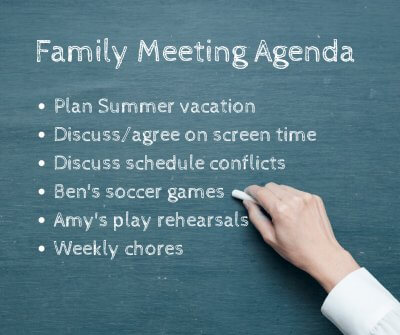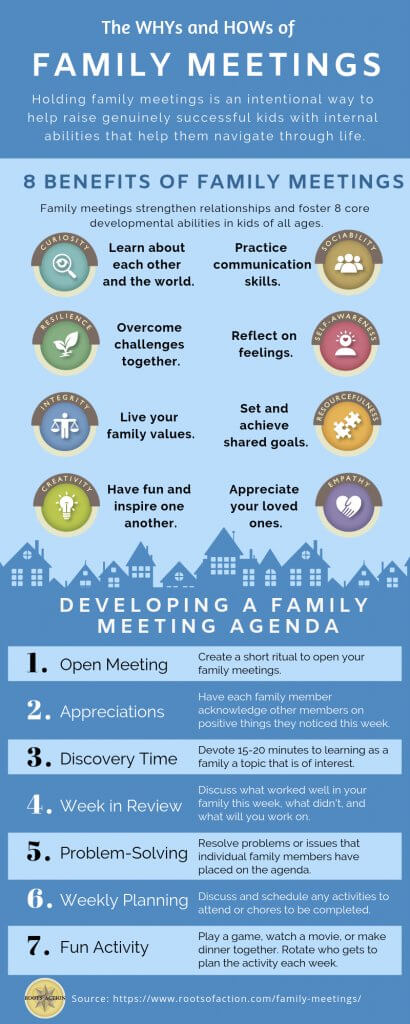
Family meetings are opportunities for parents and children to discuss important issues, strengthen communication, reinforce values, and nurture positive relationships.
Often, parents and kids are reluctant to adopt family meetings because they don’t understand their purpose and structure. Some parents fear it will lessen their authority. Conversely, children may view family meetings as a way for parents to enforce rules and restrictions.
Recently, 15-year-old Brian refused his parents’ invitation to attend a meeting, saying, “What a waste of time! Why do we need weekly family meetings to argue about the same things we argue about all week long?”
Brian’s response can be typical for children, especially teens who are trying to exert control over parental authority and don’t understand how family meetings can benefit children.
How can Brian’s parents explain the value of holding regular family meetings and invite their son into ongoing positive conversations with them and his younger sister?
When parents understand the benefits of family meetings and how to develop an effective agenda that incorporates fun, problem-solving, and family bonding, they will likely be able to explain the value and structure of meetings to their children. Together, the aim is to create habits that will help your family nurture positive relationships with your children—the core of positive youth development.
8 Benefits of Family Meetings
When effectively organized and led, there are many benefits of holding family meetings for children and parents. Family meetings strengthen relationships and foster core developmental abilities in kids of all ages. These abilities prepare children for youth leadership positions in their schools and communities as they mature and develop. Holding family meetings is an intentional way to help raise genuinely successful kids with internal abilities that help them navigate through life. Meetings provide a regular opportunity to:
- Learn about each other and the world. (Curiosity)
- Practice communication skills. (Sociability)
- Overcome challenges together. (Resilience)
- Reflect on feelings. (Self-awareness)
- Live your family values. (Integrity)
- Set and achieve shared goals. (Resourcefulness)
- Have fun and inspire one another. (Creativity)
- Appreciate and understand your loved ones. (Empathy)
Dr. Jane Nelsen, founder of Positive Discipline and author/coauthor of the Positive Discipline Series, has been teaching parents to use family meetings for several decades. If your family isn’t ready to jump right into family meetings, Dr. Nelsen offers an effective “training plan” to help introduce meetings to your family over the course of a month.
It is important to mention that some families have a pattern of arguing and violence like slapping, pushing, and hitting that can be difficult to break. Family meetings can be a strategy to reduce anger, but it is not a magic fix. If your family is experiencing these types of conflicts, please read this excellent publication from Colorado State University to assess if family therapy should be considered as a first step.
Introducing Family Meetings to Children
At first, the idea of family meetings can be intimidating to children, especially teens. One reason is because children don’t know what to expect. They are likely unfamiliar with ways families meet more formally to plan, organize, problem-solve, and make decisions.
Family meetings work well with children from about four years old onward. If you’ve never had a family meeting, take time to introduce the concept to your children before you dive in. The best time to do this is when you have their full attention, either over dinner or at another time when you’ve asked them to gather.
You might start by saying that you’ve recently learned how weekly meetings can benefit families by helping them communicate and solve problems together as a team. Because family meetings work toward building consensus, everyone has a voice and a role in solving problems. Meeting time is also an opportunity to have fun, plan trips, organize family outings and service projects, and appreciate each other.
Sharing a story can be a great way to explain some of the many benefits of having family meetings. Children hate to be nagged, right? And truth be told, parents don’t like to be naggers. One of the best stories I’ve read about how a family meeting was used to resolve a conflict and help a mom avoid nagging her children was shared by developmental psychologist, Dr. Aletha Solter:
At one of their family meetings, Dr. Solter expressed her feelings about her children leaving shoes, jackets, books, etc. in the living room instead of carrying them to their rooms after school. She put this on the meeting agenda and asked for everyone’s help in finding a solution. Her children said they “were tired after school and didn’t want to walk all the way to their rooms to put their belongings away.”
An agreement was reached that the children could temporarily place their belongings in the living room if they put them away by dinnertime each day.
“This worked beautifully at first,” said Dr. Solter, “but after about a week, my children started forgetting to put their things away before dinnertime. Instead of nagging them, I simply wrote it on the agenda again. At the next meeting, they asked me to remind them, but I replied that I didn’t like to nag. Instead, I suggested that we could have some kind of nonverbal reminder.”
“My children had previously agreed to take turns setting the table, so one of them proposed that whoever set the table would put something at the place of anyone who had left a mess in the living room. We finally came up with the idea of simply turning the person’s plate upside down as a gentle reminder that that person could not eat until he or she cleaned up the mess. Everyone agreed to this.”
Dr. Solter reported that soon after this discussion, her “daughter noticed that her brother had left his dirty socks in the living room, and gleefully turned his plate upside down. Another day, I was surprised to see my own plate upside down and noticed that I had left some packages on the living-room floor.”
“We had no further problems with this issue,” said Dr. Solter, “and continued to use this reminder until my children left for college.”
An important point about family meetings is that solutions and consequences apply to all members— adults and children. It is truly an opportunity for your children to feel SEEN, HEARD, and UNDERSTOOD by you, a core principle of the Roots of Action Parenting Promise.
You should next propose a regular, weekly meeting time. Many families like to designate a specific evening during dinner. Let your children know that you will use the first meeting to discuss a typical family meeting structure and how everyone participates in decision-making.
Develop a Family Meeting Agenda
Your weekly meetings should revolve around a family meeting agenda to which all family members may contribute. There are printable forms online that may be useful. The simplest is to post a sheet of paper on the refrigerator or bulletin board where family members can jot down agenda items, like issues to be problem-solved or who will plan a fun activity. Consider the following agenda topics, which can be shortened or lengthened as you wish. Family meetings (not including a fun activity at the end) shouldn’t go on for more than an hour—less if your children are very young.
1. Open Meeting
Create a short ritual to open your family meetings. Ways that some families open are with a poem, prayer, song, candle-lighting, etc.
2. Appreciations
Take a few minutes for each family member to appreciate, say “thanks,” compliment, or acknowledge other members on positive things they noticed this week. This may include a thank you for baking cookies, congrats on a great test score, or a kind word about something nice that a person did.
3. Discovery Time
Devote 15-20 minutes to learning together as a family. This may include discussing 1) a quote—See our Quotes for Kids Series, 2) a current event, 3) a topic like the pros and cons of technology, money management, budgeting, nutrition, exercise, citizenship, music, religion, community service, or any other topic that may be of interest to you or your family. Share your opinions and values. Listen to your children’s opinions and values.
4. Week in Review
In the New York Times Bestseller, The Secrets of Happy Families, Bruce Felier incorporated a weekly “review and retrospective” into his family meetings that included these questions:
- What worked well in our family this week?
- What went wrong in our family this week?
- What will we work on this coming week?
The key point to this section is to focus on how you are doing as a family, not on individual grievances. That comes next.
5. Problem-Solving
Dedicate this time to resolving problems or issues that individual family members have placed on the agenda. It is best to try to solve only one problem a week. If more than one issue has been placed on the agenda, find a fair way to address each one week by week. Ask each person to state his/her perspective about the problem, without judgment. Ask each person to suggest solutions. Which solutions are the most feasible? What is the agreed-upon consensus? If no consensus is reached, mull over the solutions and revisit the problem next week.
6. Weekly Planning
What is your family planning together? Trips, concerts, sports events? What chores need to be completed next week? This is a time to fairly assign tasks to each family member, sync calendars, and set goals for the future.
7. Fun Activity
This might include playing a game, watching a movie, or making pizza together. Consider rotating the responsibility for planning the fun activity each week among family members.
6 Habits That Make Family Meetings Successful
Planning and executing the agenda is a big part of making your family meetings successful, but the habits you create together are equally important to your success.
1. Setting clear ground rules
Discuss and agree on ground rules as a family so that everyone is comfortable with them. Write the ground rules down and be willing to revisit and update them as needed. When a ground rule is inadvertently broken, it should be pointed out so the person can change the unwanted behavior. Many families include the following: 1) Each person should be free to speak without judgment or interruption, and be listened to while speaking. 2) Meetings are not a time to scold, punish, or point out mistakes of individuals. 3) Consensus is always the goal when problem-solving. 4) When difficult issues cannot be solved by consensus, parents have the final word. 5) Everyone’s voice is respected, even if not everyone agrees. 6) Meetings are tech-free time.
2. Practicing family values
Family meetings are an opportunity to discuss and practice living your family values. Review together My Parenting Promise and the values and behaviors that are known to positively impact child and adolescent development. What other values are important to your family? Write them down and practice them.
3. Using “I” Statements
An “I” statement asserts the feelings, thoughts, and beliefs of the person speaking and generally begins with “I.” The most constructive use is to say, “I feel” (insert feeling word like sad, angry, happy) followed by “when” (tell what caused the feeling). Lastly, if you are asking people to change their behavior, you would say, “I would like” (tell what you want to happen instead). The use of “I” statements allows the speaker to own their feelings rather than implying they are caused by another person, causing the listener to be defensive. An “I” statement is contrasted with a “You” statement which might sound like this: “You made me angry when…” Teach your kids about the power of “I” statements by viewing this 2-minute video produced by The Mosaic Project:
4. Sharing leadership
Children are capable of leading family meetings as they mature. Encourage rotation of leadership responsibilities, starting with asking children to lead different parts of the agenda or planning of the fun family activity.
5. Being flexible
Family meetings will not always go well or accomplish what you hope. Consider them an environment to learn together as a family. When something isn’t working, imagine alternatives and adjust. Don’t give up. Keep practicing and evaluating.
6. Keeping Minutes
Make a record of the decisions you reach as a family so you can refer to them in the future. If tasks have been delegated to achieve family goals, keep those in the minutes too. You may wish to post minutes on the refrigerator so everyone knows the plan for the week.
Other Tips for Family Meetings?
If you hold regular family meetings and have tips for other families just getting started, please share your advice in the comments section below. Others will thank you for sharing your experiences.
The WHYs and HOWs of Family Meetings Infographic
Please feel free to share or print this infographic about family meetings, summarized from the material in this article:
Published: February 14, 2019





